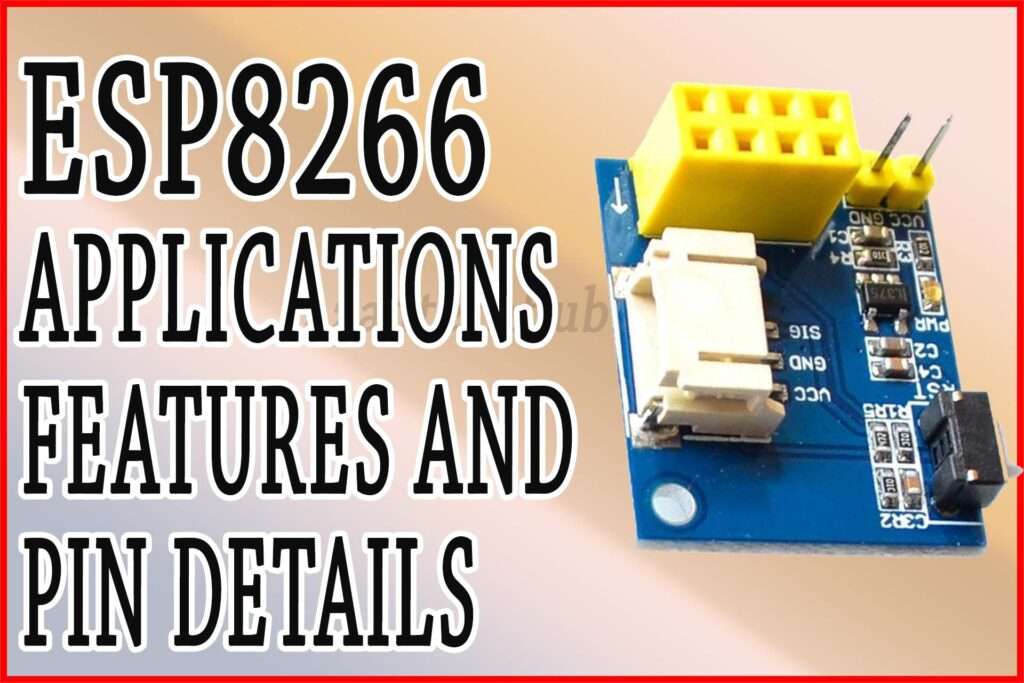ESP8266 Pinout: Important Features & Equivalent
The ESP8266 is a popular Wi-Fi module widely used in Internet of Things (IoT) projects and wireless communication applications. Understanding the ESP8266 Pinout is essential for proper connection and utilization in circuit designs.
Read More

ESP8266 Pinout
Let’s explore the ESP8266 pinout in detail.
The ESP8266 module typically consists of several pins that serve different functions. The specific pinout configuration may vary slightly depending on the module variant or development board used. Here is a general overview of the commonly used pins in the ESP8266:
GPIO (General Purpose Input/Output) Pins: These pins are used for general-purpose digital input and output operations. They can be configured as either input or output depending on the requirements of the project.
Power Pins:
VCC: This pin is used to supply power to the ESP8266 module. It typically requires a 3.3V power source.
GND: This pin is connected to the ground (0V) reference.
UART (Universal Asynchronous Receiver/Transmitter) Pins:
TX: This pin is used for serial data transmission from the ESP8266 module.
RX: This pin is used for serial data reception by the ESP8266 module.
Reset (RST) Pin: This pin is used to reset the ESP8266 module. Pulling the RST pin to LOW momentarily resets the module.
SPI (Serial Peripheral Interface) Pins:
MOSI: Master Output Slave Input pin for SPI communication.
MISO: Master Input Slave Output pin for SPI communication.
SCLK: Serial Clock pin for SPI communication.
CS/SS: Chip Select/Slave Select pin for SPI communication.
I2C (Inter-Integrated Circuit) Pins:
SDA: Serial Data pin for I2C communication.
SCL: Serial Clock pin for I2C communication.
It is important to consult the specific datasheet or pinout diagram of the ESP8266 module you are using to ensure accurate pinout connection.
Features of ESP8266 Module
- Wi-Fi connectivity for wireless communication and internet connectivity.
- Low-cost and low-power consumption.
- Integrated TCP/IP protocol stack for easy networking.
- Extensive firmware support and libraries for easy development.
- Support for multiple networking modes, including Access Point (AP) and Station (STA).
- Easy integration with microcontrollers and development boards.
Specifications of ESP8266 Module
- Microcontroller: Tensilica Xtensa LX106
- Operating Voltage: 3.3V
- Wi-Fi Standards: 802.11 b/g/n
- Wireless Range: Up to several hundred meters, depending on external factors
- GPIO Pins: Varies depending on the module variant (typically 8-17 pins available)
- Flash Memory: Varies depending on the module variant (typically 512KB to 4MB)
Equivalent ICs of ESP8266 Module
ESP8285: This is a variant of the ESP8266 module with built-in flash memory. It offers similar features and ESP8266 Pinout.
ESP32: This is a more advanced microcontroller module that offers Wi-Fi and Bluetooth connectivity. While the pinout configuration differs from the ESP8266, it provides similar functionalities and capabilities.
These equivalent ICs provide similar functionality and can be used as alternatives or upgrades to the ESP8266, depending on specific project requirements and component availability.
Worth Read Posts
Follow us on LinkedIn”Electrical Insights” to get the latest updates in Electrical Engineering. You can also Follow us LinkedIn and Facebook to see our latest posts on Electrical Engineering Topics.
